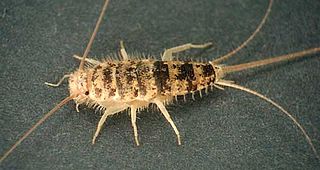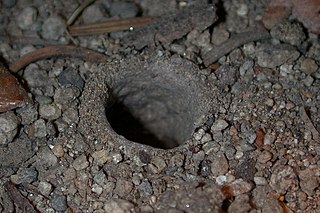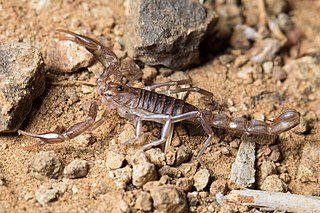
The ovipositor is a tube-like organ used by some animals, especially insects for the laying of eggs. In insects, an ovipositor consists of a maximum of three pairs of appendages. The details and morphology of the ovipositor vary, but typically its form is adapted to functions such as preparing a place for the egg, transmitting the egg, and then placing it properly. For insects, the organ is used merely to attach the egg to some surface, but for many parasitic species, it is a piercing organ as well.

Lampshade spiders, family Hypochilidae, are among the most primitive of araneomorph spiders. There are two genera and twelve species currently recognized. Like mygalomorphs, most hypochilids have two pairs of book lungs, but like araneomorphs they have intersecting fangs, with the exception of some species which have chelicerae in an angle that is neither orthognathous or labidognathous. These long-legged spiders build typical "lampshade" style webs under overhangs and in caves. In the United States the fauna is primarily associated with the Appalachian, Rocky and California Mountains. Ten of the known species are found in these ranges, all in the genus Hypochilus. The genus Ectatosticta is found in China.

The Archaeognatha are an order of apterygotes, known by various common names such as jumping bristletails. Among extant insect taxa they are some of the most evolutionarily primitive; they appeared in the Middle Devonian period at about the same time as the arachnids. Specimens that closely resemble extant species have been found as both body and trace fossils in strata from the remainder of the Paleozoic Era and more recent periods. For historical reasons an alternative name for the order is Microcoryphia.

Zygentoma are an order in the class Insecta, and consist of about 550 known species. The Zygentoma include the so-called silverfish or fishmoths, and the firebrats. A conspicuous feature of the order are the three long caudal filaments. The two lateral filaments are cerci, and the medial one is an epiproct or appendix dorsalis. In this they resemble the Archaeognatha, although the cerci of Zygentoma, unlike in the latter order, are nearly as long as the epiproct.
Lepidotrichidae is a family of basal insects belonging to the order Zygentoma. The family is considered to contain two genera: the extinct Lepidotrix, known from specimens preserved in Baltic amber, and the extant Tricholepidion, which contains a single species, Tricholepidion gertschi. This species is an example of a living fossil, the one remaining member of a clade which was once widespread. Recent research has suggested the extant species should be assigned to its own family, Tricholepidiidae.
Eulasiopalpus is a genus of parasitic flies in the family Tachinidae. There are about nine described species in Eulasiopalpus.
Eoplectreurys is an extinct monotypic genus of spider from the family Plectreuridae, with a sole species, Eoplectreurys gertschi. The fossils of Eoplectreurys were recovered from the ~164 Ma old Middle Jurassic Daohugou formation tuffs in Inner Mongolia, China.

The Vaejovidae are a family of scorpions, comprising 17 genera, all except for Paruroctonus boreus(the northernmost scorpions in the world, present in Canada) found in Mexico and the Southern/Southwestern United States.
HgeTx1 (systematic name: α-KTx 6.14) is a toxin produced by the Mexican scorpion Hoffmanihadrurus gertschi that is a reversible blocker of the Shaker B K+-channel, a type of voltage-gated potassium channels.
Sergiolus gertschi is a species of ground spider in the family Gnaphosidae. It is found in the USA and Mexico.
Dolomedes gertschi is a species of nursery web spider in the family Pisauridae. It is found in the United States.

Castianeira gertschi, the Gertsch antmimic, is a species of true spider in the family Corinnidae. It is found in the United States and Canada.

Hypochilus gertschi, or Gertsch's lampshade-web spider, is a species of lampshade weaver in the family Hypochilidae. It is found in the United States.
Cesonia gertschi is a species of ground spider in the family Gnaphosidae. It is found in the United States and Mexico.
Micaria gertschi is a species of ground spider in the family Gnaphosidae. It is found in the United States and Canada.
Taracus gertschi is a species of harvestman in the family Taracidae. It is found in North America.

Atypoides gertschi is a species of folding-door spider in the family Antrodiaetidae. It is found in the United States.

Hyptiotes gertschi is a species of cribellate orb weaver in the spider family Uloboridae. It is found in the United States and Canada.
Trechalea gertschi, the long-legged water spider, is a species of true spider in the family Trechaleidae. It is found in the United States and Mexico.

Serradigitus is a genus of sawfinger scorpions in the family Vaejovidae. There are more than 20 described species in Serradigitus.










